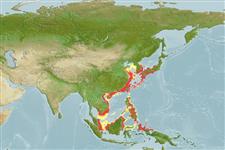Common names from other countries
Environment: milieu / climate zone / depth range / distribution range
экология
морской; солоноватоводный; пределы глубины 5 - ? m (Ref. 12166). Tropical; 39°N - 1°S, 103°E - 138°E (Ref. 54449)
Indo-Pacific: Indian Ocean (Kuwait Bay and Pondicherry), Java Sea (Singapore), East China Sea (Canton north to the Koreas and southern Japan, as far as Osaka on the Pacific coast and Fukuoka in Sea of Japan, also Peter the Great Bay in Soviet waters).
Size / Вес / Возраст
Maturity: Lm ? range ? - ? cm
Max length : 60.0 cm TL самец/пол неопределен; (Ref. 56557); common length : 30.0 cm TL самец/пол неопределен; (Ref. 27773); наибольший вес (опубликованные данные): 140.00 g (Ref. 4883)
Краткое описание
определительные ключи | морфология | морфометрия
колючие лучи спинного плавника (общее число) : 0; колючие лучи анального плавника: 0; членистые (мягкие) лучи анального плавника: 43 - 53. Body slender, belly with usually 24 to 25 + 10 to 15, total 34 to 42 scutes. Eye large, lower jaw projecting. Dorsal fin origin at about midpoint of body or a little behind; anal fin origin a little behind dorsal fin base. Swim bladder with a long tube passing back down right side of body above anal fin base.
Found inshore, entering estuaries and presumably able to tolerate lowered salinities; also found in semi-enclosed sea areas (Ref. 11230). A warm-water species that does not reach the northern part of its range in cool years. Used in Chinese medicine (Ref. 12166).
Whitehead, P.J.P., 1985. FAO Species Catalogue. Vol. 7. Clupeoid fishes of the world (suborder Clupeoidei). An annotated and illustrated catalogue of the herrings, sardines, pilchards, sprats, shads, anchovies and wolf-herrings. FAO Fish. Synop. 125(7/1):1-303. Rome: FAO. (Ref. 188)
Статус Красного Списка МСОП (Ref. 130435)
CITES (Ref. 128078)
Not Evaluated
Угроза для людей
Harmless
Использование человеком
рыболовство: важный объект промысла
дополнительная информация
инструменты
Специальные отчеты
Скачать в формате XML
ресурсы в Интернет
Estimates based on models
Preferred temperature (Ref.
115969): 17.6 - 29, mean 27.9 (based on 396 cells).
Phylogenetic diversity index (Ref.
82804): PD
50 = 0.5000 [Uniqueness, from 0.5 = low to 2.0 = high].
Bayesian length-weight: a=0.00676 (0.00437 - 0.01045), b=3.02 (2.90 - 3.14), in cm Total Length, based on LWR estimates for this species & Genus-body shape (Ref.
93245).
Trophic level (Ref.
69278): 3.8 ±0.61 se; based on food items.
устойчивость к внешним воздействиям (Ref.
120179): средний (среднего размера), минимальное время удвоения популяции 1.4-4.4 года (tm=2; Tmax=6-7; K=0.2-0.4).
Prior r = 0.88, 95% CL = 0.58 - 1.32, Based on 4 data-limited stock assessments.
Fishing Vulnerability (Ref.
59153): Low to moderate vulnerability (34 of 100).
Climate Vulnerability (Ref.
125649): Moderate vulnerability (38 of 100).
